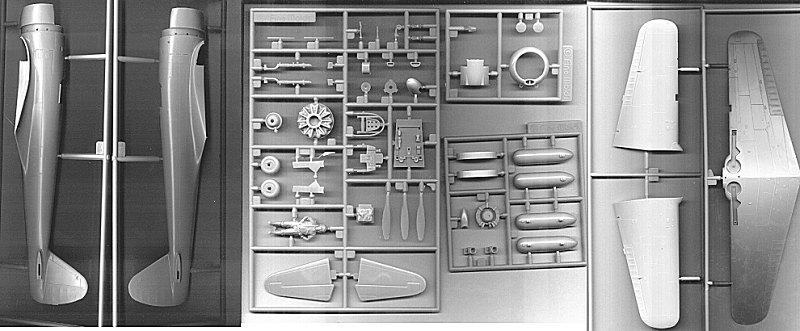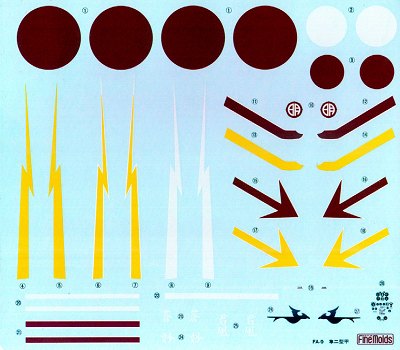
|
KIT: |
Fine Molds 1/48 Ki-43-IIa 'Oscar' |
|
KIT # |
FB 2 |
|
PRICE: |
$26.95 |
|
DECALS: |
See review |
|
REVIEW & |
|
|
NOTES: |
|

|
HISTORY |
Every Air Force that fought in the Second World War had its workhorse, a fighter that was operational when hostilities began that was still in combat when the war ended, amendable to adaptation for a variety of roles, and encountered in every theater of war in which the Air Force it served was engaged. For the USAAF, this was the P-40; for the RAF, the Spitfire; for the Luftwaffe, the Bf-109; for the Imperial Navy it was the Zero. For the Imperial Army Air Force, it was the Nakajima Ki.43 "Hayabusa," or "Peregine Falcon," known to its enemies by the reporting name "Oscar."
After the Nomonhan "incident" in August-September 1939, even the die-hard fighter pilot traditionalists of the JAAF were forced to admit that the nimble Ki.27, the service's first modern monoplane fighter, might not be the equal of its possible Western opponents, even with its terrific maneuverablity in close-in high-g combat. Fortunately, a successor was already in the prototype stage.
Essentially, the Ki.43 was a compromise between the traditionalists and the modernists, who managed to put the Ki.44 into production - the first Japanese fighter in which speed and heavy armament were considered more important than maneuverability. What was wanted with the Ki.43 was the maneuverability and cockpit visibility of the Ki.27, speed, climb rate and range had to better the outstanding individual characteristics of all known fighters then under development. The specification did not include pilot armor or self-sealing fuel tanks; the omission was later to be regretted, but it allowed a sufficient weight saving so that the Ki.43-I, using a newly-developed "combat flap," was able to meet the requirements of the uncompromising JAAF pilots as regards maneuverability.
Compared to the A6M-2 Model 21 Zero, which had a similar powerplant, the new Ki.43-Ic had an appreciably lower wing loading and power loading, but was inferior to the A6M2 in overall maneuverability and armament - the Ki.43 having two 12.7mm machine guns compared to the A6M2's two 7.7mm machine guns and two 20mm cannon.
The Ki.43 only equipped the 50th Sentai at the time of the outbreak of the Pacific War, and received its baptism of combat in Burma, where the airplane would find its major employment throughout the war. While AVG pilots claim they were fighting IJN Zeros, in fact they were opposed by the Oscars of the 50th Sentai. Given an overall similarity in layout, and Allied unfamiliarity with Japanese designs in 1942, the mistake was easy to make; what is interesting is that 50 years later, surviving Tigers still claim they fought the superior Zero, proof that pilot's egos never change (another example is the fact that Germans overclaimed Spitfires by about 3:1 and underclaimed the "lesser" Hurricane by about the same ration, a Spitfire kill ranking higher within the fraternity).
The Ki.43-Ic was followed by the Ki.43-IIa, which went into production in May 1943, with increased engine power and increased fuel. The Ki-43-IIc (KAI), with clipped wingtips, entered operational service that summer, serving in Burma and New Guinea, with nearly every JAAF unit in those theaters. It would serve to the end of the war, fighting in the Philippines in 1944, as well as in China from 1943 onward. Although the airplane was not an exceptional fighter by world standards, more Ki.43s were operational with the JAAF during the Pacific War than any other type.
|
THE KIT |

The Fine Molds Oscar was first released in 1994, and marked the end of the company's fling with advanced model creation, i.e., the use of white metal and photo-etch for finer detail of landing gear and cockpits. The kit was completely injection molded, and still priced at more than $40, which led to it not being a commercial success in the United States. Fine Molds has now re-released the kit at a competitive price.
 The kit purports
to be a Ki.43-IIa, but is actually a mish-mash of Ki.43-IIa and Ki.43-IIc: it
has the single exhaust of the Ki.43-IIa, and the "clipped" wing of the
Ki.43-IIc. Given that it is impossible to add four additional scale feet to the
overall wingspan, the modeler will be better off modifying the exhaust to the
multiple stacks of the later version; fortunately this will not be difficult,
using .015 Evergreen rod with a bit of cutting and filing.
The kit purports
to be a Ki.43-IIa, but is actually a mish-mash of Ki.43-IIa and Ki.43-IIc: it
has the single exhaust of the Ki.43-IIa, and the "clipped" wing of the
Ki.43-IIc. Given that it is impossible to add four additional scale feet to the
overall wingspan, the modeler will be better off modifying the exhaust to the
multiple stacks of the later version; fortunately this will not be difficult,
using .015 Evergreen rod with a bit of cutting and filing.
The decals provided are for five Ki.43-IIa's of the 50th Sentai (3) which saw combat in Burma; the 64th Sentai (2) which also fought in Burma; the Akeno flying School (1) in the Home Islands; and the 59th Sentai (2) which saw combat in New Guinea. Given the mistake of the kit, it will really not be possible to make models of the specific aircraft represented, though it will be possible to make Ki.43-IIc aircraft of each unit, which might have been flown by the pilots mentioned in the markings instructions. My own suggestion is you obtain the Osprey Aircraft of the Aces No. 13, "Japanese Army Air Force Aces," and figure out one of those aircraft.
|
CONCLUSIONS |
Despite the mistake with the wings and exhaust, with a little bit of work this will make up into a very convincing model of the JAAFs most ubiquitous fighter. It will look good sitting between the Hasegawa K.27 and Ki.44, near the K.87, as a representation of the major fighting aircraft of the JAAF in the Pacific War.
As an addendum, shortly after its original publication, I was contacted by Pete Chalmers, an acknowledged expert on the subject, who told me that all Oscar IIs have the "short" wing. Here we have a perfect example of what I mean in other articles about checking your research. I went through three different books, who provided the information I quoted about when the "short" wing showed up. Obviously, this is the kind of "standard research" where one guy makes a mistake and the two following copy it.
Therefore, for all concerned, here is the accurate information on the Fine Molds kits per Pete's e-mail:
"The Multi stack version is the " III Ko" - Kit FA-11 in the original series. Kit FA-9 " II Ko ", provides both early and late oil cooler variations II a and II b ) and is the same as the new kit FB-2. Kit FA-10 is the " II Otsu" ( IIc ) with the straight back single exhaust and fuel cooler. All the Fine Molds kits are accurate - not so the Nichimo, which has outline errors."
Thanks to HobbyLink Japan (http://www.hlj.com) for the review copy.
If you would like your product reviewed fairly and quickly by a site that has over 800 visits a day, please contact me or see other details in the Note to Contributors.